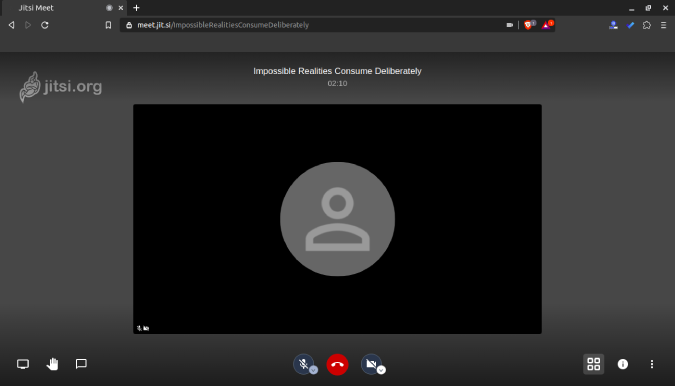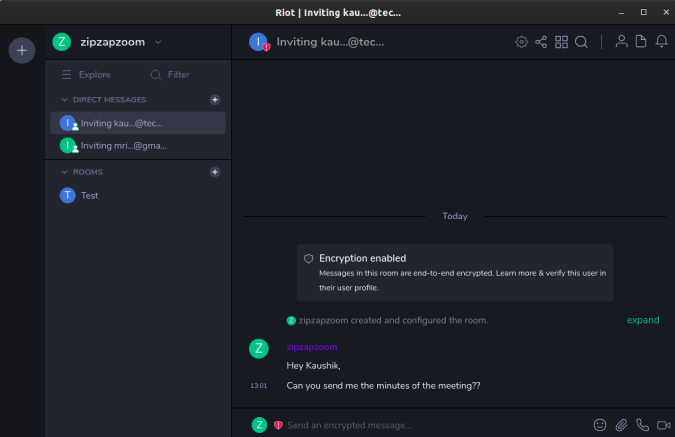Zoom is currently the most popular video conferencing app globally. However, the service is not end-to-end encrypted. It does use TLS to encrypt your data, but the Zoom servers can still potentially access your meeting data. To top it, came the controversial Motherboard report which stated “Zoom iOS app was sending data to Facebook even if the user wasn’t even registered on Facebook. Moreover, Zoom has a bunch of woes. So, if you are looking for a more private and secure alternative, here’s a list of open-source video chat alternatives.
Open-Source Secure Zoom Alternatives
All these apps are open-source and more-or-less earns from companies collaborating with it. Hence, all these apps are free to consumers and they even allow you to host the video conferencing app on your personal server.
1. BigBlueButton
Limit: 150 people
BigBlueButton is a free open-source web conferencing system designed for online classes. So, basically, it means that it doesn’t have a dedicated desktop or mobile app. You have to host and attend web conferences over an HTML5 browser (Chrome/Firefox) only. But, even on the browser, BigBlueButton works like a charm. Foremost, similar to Skype and Zoom, you don’t have to register to attend a meeting.
Due to increased demand, recordings are temporarily disabled and the maximum duration of a meeting has been reduced to 60 minutes on BigBlueButton’s server.
You have the usual features like public and private chat, screen share, file share, whiteboard for annotation and explanatory, etc. However, unlike Zoom, group polling is free and you get to run polls during your meetings. Moreover, breakout rooms are also available. In case you don’t know, breakout rooms let you furthermore group participants into small groups for collaboration.
BigBlueButton doesn’t have a paid model but you can consider Elos (formerly known as Mconf) to be the paid version. It starts as low as $5/person and provides a bunch of extra features like cloud recording, monthly reports, etc.

What’s good?
- Unlimited number of users in a web conference
- No sign up required to attend a video conference
- Features like public and private chat, screen share, breakout rooms, polls, etc
- University app integration like Drupal, Canvas, Wordpress, etc
- File sharing
- Ability to host the video conferencing apps on your own server
What’s not?
- No dedicated Android and iOS apps
- Cannot share screen on mobile
- No end-to-end encryption
Visit BigBlueButton
2. Jitsi Meet
Limit: 75 people
Jitsi Meet lets you both attend and host meetings without registration. This, however, does come with a few downsides and we’ll get to it in a bit. Similar to other video conferencing apps, you have the usual stuff like public & private chat, screen sharing, recording, etc. Additionally, it has the popular “Blur my Background” feature that might remind you of Skype.
The most unique things about Jitsi Meet is sharing a YouTube video. Moreover, you can start a live YouTube stream within Jitsi Meet as well. These tools do come in handy if you planning to go live with a bunch of remotely placed people. It also supports meeting recording but you need to have a Dropbox account for it.
Jitsi Meet works on the same Zoom principle where you have an auto-generated meeting name that the attendees have to enter in order to join your meeting. However, these meeting IDs can be manually entered so there are high chances of meeting name collision. Since you can create a meeting without signing in, no one is a moderator. Meaning, anyone can kick someone out of a meeting or mute other participants. This might not be a concern in a formal meeting but if you are taking a webinar with people over the Internet, moderation is a serious concern.

What’s good?
- No sign up required to attend or host a video conference
- Features like public and private chat, screen share, cloud recording, etc
- Inbuilt integration with Etherpad
- Skype-like Blur my Background feature
- Ability to host the video conferencing apps on your own server
What’s not?
- Moderation controls are just vague
- No end-to-end encryption
- No white screen or file sharing
Visit Jitsi.org
3. Jami
Maximum Limit: Unlimited
Unlike BigBlueButton and Jitsi Meet, Jami is not a web conferencing app and has dedicated desktop and mobile apps. It is also end-to-end encrypted and works on a peer-to-peer communication model. In case you don’t know, peer-to-peer communication works between the caller and the receiver. The data is not routed via an intermediate server. But, since it works peer-to-peer, you have to download and register on Jami because this unique username (40-character long ID internally) is used to identify you across networks.
Jami has all the required tools for a video chat app but it somehow doesn’t feel like a group solution to me. In order to initiate a video conference, first, you have to add all users to your contact and then add them to the video call. This makes sense for privacy but it is not your run-and-gun video conferencing app.

What’s good?
- End-to-End encrypted calls and peer-to-peer communication
- Dedicated apps for Windows, macOS, Linux, Android, iOS, AndroidTV
- No file-sharing limit and video conferencing limit
- LAN based video conferencing without Internet
What’s not?
- Connecting a video conference is still a task wherein you have to add contacts individually
Visit Jami
4. ezTalks Cloud Meeting
Maximum Limit: 100 people
ezTalks is another open-source video conferencing app just like Zoom. And Zoom is not just a reference for ezTalks, it is like Zoom in every sense. The pricing model, video call limitations, and the interface, everything reminds me of Zoom. It also works on an 8-9 digit meeting ID that you can use to join meetings. Quite similar! But, you know there’s no harm in copying the good bit.
ezTalks is free and lets you hold a group video call of 100 people with a 45-minute video limit. You can also join-in a meeting without signing-up. On top of the usual features in Zoom, ezTalks also provides a free group poll. It also provides 1 GB of cloud storage for every free user. This enables you to record meetings in the mobile app as well. Moreover, it also provides you the option of holding webinars for a vast number of people over the Internet (100 mins in the free variant).

What’s good?
- Gallery view to accommodate a bird-eye view of the meeting
- Local video recording plus cloud storage of 1 GB for each free user
- Simultaneous screen sharing and remote control
- Group polls in the free variant
- Google Calendar and Office 365 integration
What’s not?
- No app for Linux
- Hosting and joining a meeting requires downloading the desktop app
Visit ezTalks Cloud Meeting
5. Linphone
Maximum Limit: 8 people
Unlike other apps in this list, Linphone is an open-source app dedicatedly built for VoIP calls. It works with any SIP provider. You can configure your SIP ID in Linphone and take your phone calls within the app. Additionally, Linphone can also do group video calls. But, similar to Jami, you have to add all your contacts before you can initiate video calls.
My most favorite feature about Linphone is that it lets you take multiple audio and video calls at once. You can pause, merge calls and quickly switch between them. It also provides an echo cancellation switch to cut down the echo during calls. It also maintains a call history and lets you record calls as well.
Linphone works great when it comes to group conferencing. However, the audio and video conferencing limits max out at 8 people which is quite small. Moreover, the end-to-end chat encryption only works on mobile apps.

What’s good?
- Handle multiple audio and video calls by pausing calls
- Ability to cancel echo from your calls
- Dedicated mobile apps for Android and iOS
What’s not?
- End-to-End encryption only for messages on the mobile app
- You need to add contacts before starting a group video call
- Maximum limit of 8 people is quite less
Visit Linphone
6. Riot
Maximum People: Unlimited
Similar to Jami, Riot is also an end-to-end encrypted communication tool. But unlike Jami, it does have a web app. However, that’s not what’s unique about Riot. You can consider Riot as an entire communication tool like Slack or Microsoft Teams, end-to-end encrypted though! Similar to Slack, it lets you create your workspace wherein you invite your team and chat, create groups, hold video calls and conferences, etc. The app interface is similar to that of Slack and is pretty easy to use.
The only underlying difference between Slack and Riot is Matrix. Unlike Slack which uses its own servers, Riot uses the cloud services from Matrix. Hence in the free variant of Riot, you don’t get your own custom workspace name and data is stored on a public Matrix server. It’s encrypted, though and no one can access it. So, for a custom workspace, you would have to shell out as much as $10/month (5 users). Moreover, Riot uses Matrix which is an open-source protocol and you can chat with users on Slack as well.

What’s good?
- End-to-End encryption
- Entire communication tool with chat, groups, video conferencing, etc
- Uses open-source Matrix model and provides communication to Slack as well
- Features like file sharing, groups, video calls, audio calls, screen sharing, etc.
- Ability to host on your own server
What’s not?
- Not too many bots as compared to Slack
Visit Riot
Comparison Table
| Products | Participant Limit | Time Limit | Local Recording | Join via Browser | Mobile Apps |
| BigBlueButton | 150 | 60-mins | ✔︎ | ✔︎ | ✘ |
| Jitsi Meet | 75 | — | ✔︎ | ✔︎ | ✘ |
| Jami | Unlimited | — | ✔︎ | ✘ | ✔︎ |
| ezTalks Cloud Meeting | 100 | 45-mins | ✔︎ | ✘ | ✔︎ |
| Linphone | 8 | — | ✔︎ | ✔︎ | ✔︎ |
| Riots | Unlimited | — | ✔︎ | ✔︎ | ✔︎ |
Closing Words
For a one-off webinar, Jitsi Meet is a good platform. BigBlueButton is an ideal alternative if you are considering to replace Zoom for your university or school. For a long term solution, you might have to look for Slack or Microsoft Teams.
In case you want a more open-source alternative to 1-on-1 video chats, Signal and Telegram is a good option. For an open-source chat application, Session is another good alternative. For more issues or queries regarding Zoom and video conferencing, let me know in the comments below
Also Read: Apps to stay Productive when Working From Home